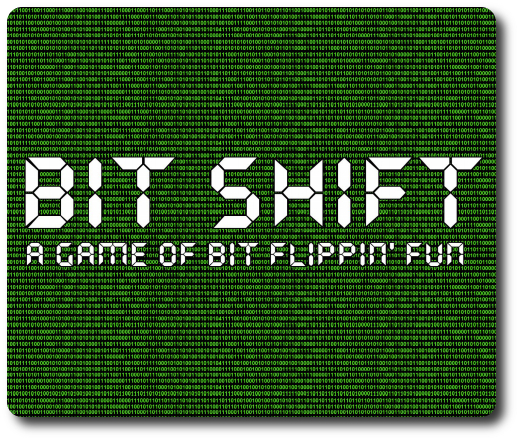
The Basics:
- For ages 5 and up (publisher suggests 12+)
- For 1 to 4 players
- Approximately 15 minutes to complete
Geek Skills:
- Counting & Math
- Logical & Critical Decision Making
- Pattern Matching
- Hand/Resource Management
Learning Curve:
- Child – Easy
- Adult – Easy
Theme & Narrative:
- None
Endorsements:
- Gamer Geek rejected!
- Parent Geek approved!
- Child Geek mixed!
Overview
Any programmer who knows their stuff can tell you what a “bit” is. For those who don’t know, it’s the smallest unit of information capable on a machine. While a human will only see a zero or a one, the computer reads it as “True” or “False”, “On” or “Off”, and “Yes” or “No”. Essentially the base of the most basic of decision making requirements. While this game will not teach you how to program, it will most certainly get your brain working.
Bit Shift, published by Wolfpack Studios, is comprised of 1 game mat, 54 Bit Sequence cards, and 8 black Bit tokens. The game mat and game cards are made of thick card stock and the Bit tokens are made of thick plastic. The entire game has a very minimalistic and abstract feel, with an eye for simplification of form and color. Flash and fanfare have been set aside to provide a straightforward game play experience with focus on function. And yet, there is still a visible artistic direction throughout the game that keeps it all firmly in place, both thematically speaking and within the context of game play.
fathergeek@thegametable [/]# run ./game_setup
To set up the game, place the game mat in the middle of the playing area.
Second, shuffle the Bit Sequence cards and deal out to each player 5 cards, face-down. Players should look at their cards but keep them hidden from their opponents at all times.

Bit Sequence card example
Third, place the deck of Bit Sequence cards face-down and to one side of the game mat (this is now the draw deck), leaving room for a discard pile. Flip the top card and orientate it so the card’s top and bottom match the game mat’s top and bottom (indicated by a “0” and a “1”). Take the 8 Bit tokens and place them on the numbers (one row is all zeros and the other row is all ones) so the resulting visible number is a bit sequence that matches the Bit Sequence card. Place the Bit Sequence card to one side of the draw deck, face-up, to create the discard pile.
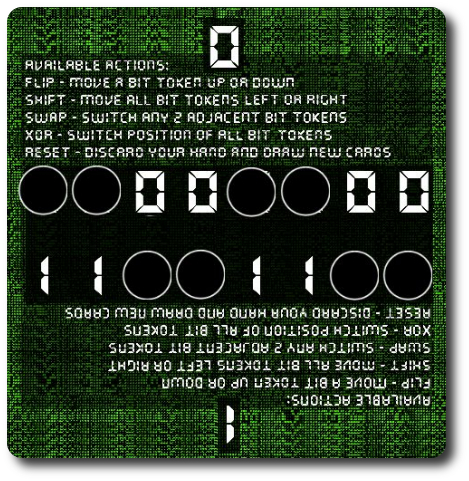
Game mat example with Bit tokens in place
That’s it for game set up. The next player going clockwise from the player who dealt goes first. Before the game begins, remind every player to orientate their Bit Sequence cards so the “0” or the “1” at the top of each of the cards is orientated to the game mat based on their sitting position. This will make it much easier for the players to read their Bit Sequence cards in relationship to the current bit sequence on the game mat.
fathergeek@thegametable [/]# run ./bit_shift
Bit Shift is played in turns. Each turn allows the player to take a single action. These actions are summarized here.
Flip
This action allows the player to take 1 Bit token and flip it from “0” to “1” or from “1” to “0”. The token is moved up or down only.
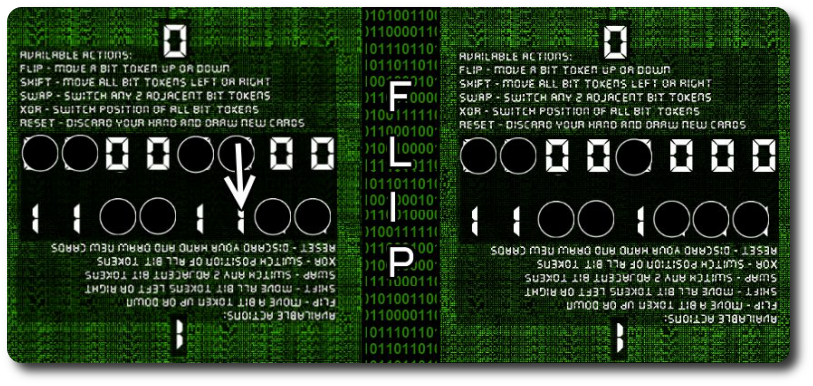
Shift
This action allows the player to shift all the Bit tokens one space, in both rows, either to the right or to the left. The tokens “wrap”, meaning if the Bit token would travel off the game mat, it is placed on the opposite side of the game mat. For example, if the Bit token is shifted off the game mat to the right, it is placed on the left most position of the same row. In this way, all Bit token placements shift, but not their value. A “0” Bit token will still be a “0” and a “1” Bit token will still be a “1” after the shift, but their position in the sequence will have moved one space to the left or to the right.
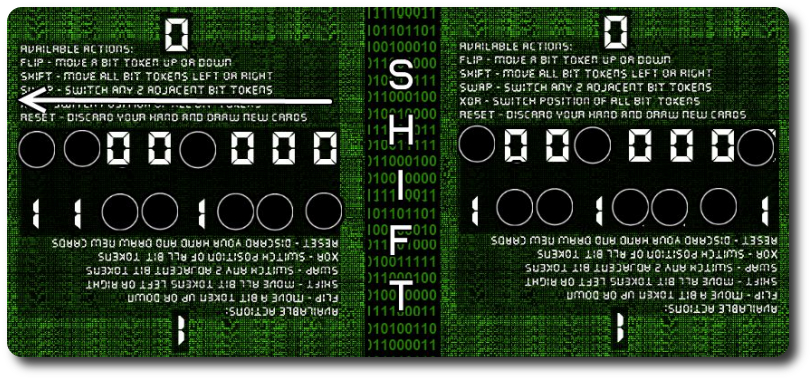
Swap
This action allows the player to swap to adjacent Bit tokens, but only if the two Bits tokens will NOT be the same value. For example, a player could not swap a “0” with another “0” or a “1” with another “1”.

XOR
This action allows the player to completely reverse the Bit Sequence on the game mat. Every “0” becomes a “1” and every “1” becomes a “0”. The XOR is just like the Flip action, except it flips every Bit token.
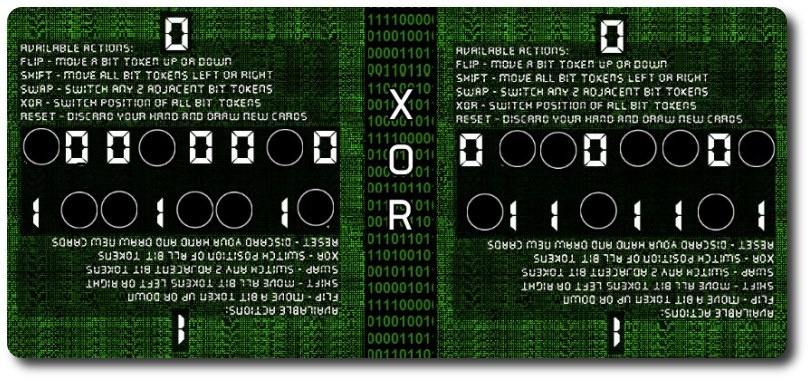
Reset
This action allows the player to discard all their current Bit Sequence cards into the discard pile and draw an equal number of cards to replace them. If there are no cards to draw or not enough, simply shuffle the discard pile and flip it face-down to make a new draw deck.
Note: Players can only take one of the actions listed above, but when taking them, they cannot perform an action that is the inverse of what their opponent just did. In other words, a player cannot take an action that undoes what their opponent just did. For example, if the opponent right before the player took the XOR action, the player could not also take the XOR action. However, when an opponent takes the Shift action, the next player can also take the Shift action if they shift the Bit tokens in the same direction as they were last shifted.
After any player completes their action, all players should take a moment to review the current bit sequence on the game mat and attempt to find a match with their Bit Sequence cards. If there is a match, the player should state as such and place their card face-up in front of them. Any opponent who wishes to do so should take a quick moment to inspect the bit sequence on the game mat and the now visible Bit Sequence card to ensure they match. If they do, the player has scored 1 Bit Sequence card. Scored cards are placed in front of the player, face-up. The player then draws a new card to replace it. There is no penalty for incorrectly calling out a bit sequence match other than the fact that the player’s opponents now know what pattern to avoid.
fathergeek@thegametable [/]# run ./calculate
The game continues until a player successfully scores a number of Bit Sequence cards.
- For a 2-player game, the first to score 8 Bit Sequence cards wins
- For a 3-player game, the first to score 7 Bit Sequence cards wins
- For a 4-player game, the first to score 6 Bit Sequence cards wins
fathergeek@thethegametable [/]# run ./variant
The game can also be played solo. The game set up and game play is the same. The only difference is the game’s overall duration. For the standard game, there is no time limit imposed. For a solitaire game, the player is attempting to score 8 Bit Sequence cards within a set number of turns. There are three levels of difficulty.
- Easy = 30 turns
- Medium = 24 turns
- Expert = 16 turns
fathergeek@thethegametable [/]# run ./houserules
If the game is running a bit long or you don’t have a lot of time, you are always welcome to reduce the needed number of scored Bit Sequence cards to win the game. When playing with younger Child Geeks, we found that reducing the necessary number of scored Bit Sequence cards to win allowed for a shorter and more enjoyable experience. Of course, if a longer game is wanted, simply increase the number of scored Bit Sequence cards necessary to win.
To learn more about Bit Shift and read the full rules, visit the game’s web page on the Game Crafter.
Prediction
Let’s first make sure everyone understands that you do not need to know how to program or even be computer savvy to play Bit Shift. While bits (a unit of information expressed as either a “0” or “1” in binary notation) are used in the game, a player need only recognize the difference between a “0” and a “1” to play. This makes Bit Shift a very easy game to learn and should not be threatening to anyone, least of all Grandma who thinks a computer is an oversized calculator that makes toast.
The actions that players can take are very straight forward. I have no doubt I’ll be able to teach this game to my 5-year-old with no issues whatsoever. I also don’t think the non-gamers we will be inviting to play this game will have any problems with it. As far as the usual groups go, I’m predicting the Child Geeks and the Parent Geeks will enjoy the straightforward challenge and the simplicity of the game play. I don’t believe there is enough in Bit Shift to appeal to the Gamer Geeks, however. You don’t have to dig down very deep in the game to realize it is just a game about shifting tokens to complete a pattern match. But then again, it’s not all that easy to do, as the more players there are in the game, the more times the tokens will shift. Perhaps the Gamer Geeks will enjoy the game because of that challenge…but they are just as likely to be annoyed by it, too. We’ll just have to see.
Both of my little geeks had no problems learning how to play Bit Shift. I was particularly pleased how quickly my 5-year-old caught on to how the game was played. I should note that he is a puzzle nut and has always enjoyed visual problem solving and pattern matching. My 8-year-old also had no problems. The only questions they had were about the Swap action, which is the most difficulty to simply explain (that’s why I included the images for each action). All it took was a few examples, and they got it. And so, hearing no other questions or concerns, I handed the deck of cards to my 5-year-old to shuffle and deal out. As he did so, I asked them both what their thoughts on Bit Shift were so far.
“This looked like it was going to be a computer game, but I can now tell it’s just a pattern matching game.” ~ Liam (age 8)
“After this, will I know how to program a game, Daddy?” ~ Nyhus (age 5)
Well…no, but the basic fundamentals of binary operations are introduced in Bit Shift. Who knows…this might be a game that sparks a long-lasting interest in computer science. Highly doubt it, but our most pressing concern is the game itself, not my children’s possible future career in the tech industry. Let’s get to it and see if this game is a winner or it divides by zero (know your meme, people).
Final Word
The Child Geeks were very mixed when it came to enjoying Bit Shift or not. None of the Child Geeks we played the game with had any problem playing or understanding the game’s goal. In fact, I didn’t observe anything to suggest that the Child Geeks were confused about any aspect of the game. It was the back and forth of the bit shifting, ironically, that divided the Child Geeks who approved of Bit Shift and those who did not. For the Child Geeks with less patience, shifting the Bit tokens back and forth became a tedious exercise after the first five or so minute. The average game length is about 15 minutes, but the game can go much, much longer if the players are not logically thinking through their actions and how they shift the tokens. For other Gamer Geeks, this wasn’t even an issue and they played the game fully engaged from start to finish, no matter if the game length was 10, 15, or 20 minutes long. In the end, I couldn’t get a strong enough read from the Child Geeks to suggest that their group approved it or not. Individual approval of the game appeared to always be based on the level of tolerance and patience the individual Child Geek had.
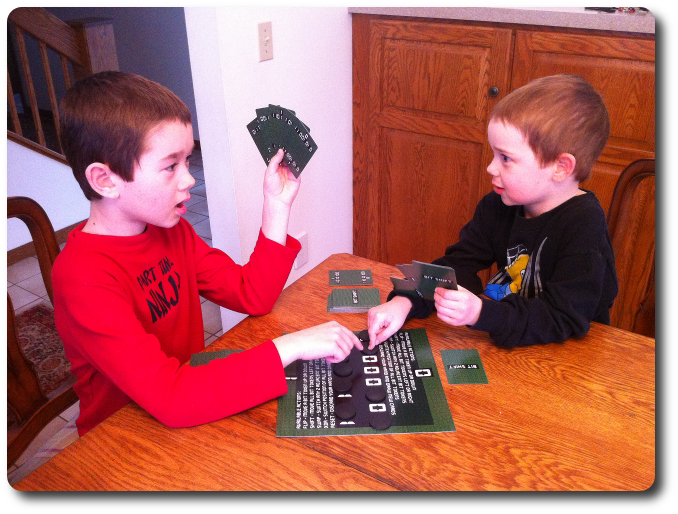
My two older little geeks argue over the correct way to “shift” a bit – My 5-year-old looks half crazy
The Parent Geeks, especially those who had a computer background, immediately enjoyed the game’s abstract look and feel. A few were even disappointing that they were not required to program, while the majority of Parent Geeks were most pleased that they didn’t have to know what a “bit” was to play. The Parent Geeks didn’t think Bit Shift was a game they would like to play with their peers unless it was just a 2-player game, as most thought this was the best way to play it. The Parent Geeks were a bit mixed on the validity of the game as a “family game”, but a few game plays convinced them that there was enough player back-and-fort in Bit Shift to make it a worthwhile experience at the family table. The Parent Geeks approved Bit Shift for its interesting mix of complexity and simplicity.
Gamer Geeks liked the “idea” of the game, but not the game play. As predicted, the Gamer Geeks thought the game was nothing more than simple pattern matching through actions that made the exercise of doing so a bit frustrating at times. Their frustration reached new record highs when they accidentally completed a match for an opponent or an opponent got lucky when they took the Reset action. Many angry words were shouted, followed by grumbles. Overall, they had no problem with the game and thought the design was sufficient for the game play it provided. But none of them thought it was a game that should get their level of approval. The words used to describe Bit Shift were “bland”, “meh”, and “functional at best”. Thumbs up all around for good effort and challenge, but not a game they would want to play on their elitist game table.
Bit Shift is a game that challenges a player to logically think through their moves while at the same time attempting to match up to 5 bit sequence patterns. Although, I would strongly recommend to a new and younger player that they just focus on creating one or two bit sequences each turn, all players have a chance of scoring a card even when not taking an action. This keeps all the players in the game and makes moving the Bit token a risk that every player must take. Not knowing what the opponents’ have doesn’t detract from the logical thinking necessary to play the game, however, but there is nothing in the way of strategy or tactics as a result. A player simply takes their turn, moves the Bit token or tokens that they think will best benefit them, and then crosses their fingers that they didn’t just give a point to another player. If it sounds a bit tedious, it can be at times, but the game play is so fast and furious that a player never really has to consider it. A game with more players take less time, which might not be obvious. But when you consider that the bits are shifting more often, this increases the odds of the player getting a match every turn. Thus, more scores and shorter games as a result.
I like Bit Shift and I think it’s an interesting game idea that takes a very simple game mechanism and puts a slightly different twist on it. There’s enough challenge to keep players interested and the game play is very straight forward. I think it’ll appeal to the older Child Geeks and Parent Geeks the most, but won’t keep general player interest for long periods of time – the game is simply not that deep. But it is an interesting game, and for those who like a pattern matching challenge, Bit Shift is sure to please.
This game was given to Father Geek as a review copy. Father Geek was not paid, bribed, wined, dined, or threatened in vain hopes of influencing this review. Such is the statuesque and legendary integrity of Father Geek.



